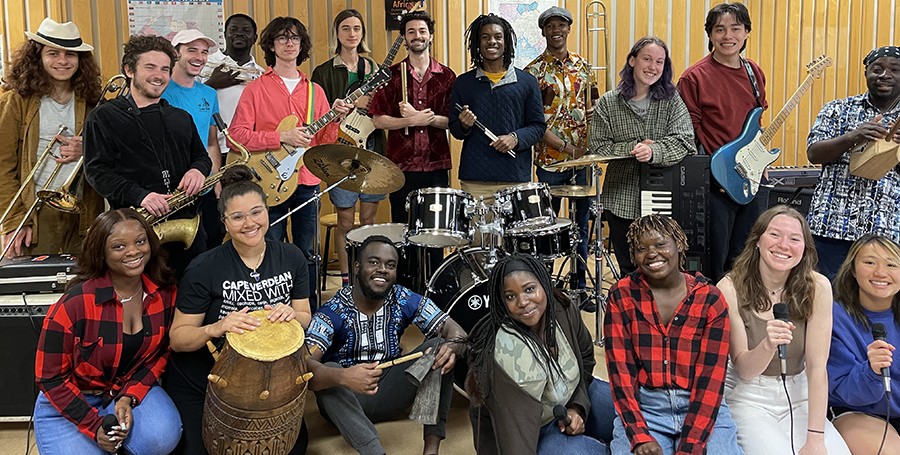
Source: Ghanaija
The dawn of the 21st century brought a new wave of creativity and innovation to the world of pop music. This transformation was driven by technological advancements, cultural exchanges, and the rise of the internet. To understand the evolution of pop music in this era, let’s journey through various African regions and meet some characters who played pivotal roles in shaping the genre.
Lagos, Nigeria: The Rise of Afrobeats
In the bustling city of Lagos, Nigeria, a young musician named Tunde dreamt of creating a sound that blended traditional African rhythms with modern pop elements. Inspired by legends like Fela Kuti, Tunde started experimenting with beats and melodies that reflected the vibrant spirit of his homeland. By the early 2000s, he had become a pioneer of Afrobeats, a genre that combined African percussion, jazz, highlife, and funk with contemporary pop music.
Tunde’s music quickly gained popularity not only in Nigeria but across the world. Songs like “Lagos Vibes” and “African Groove” resonated with audiences globally, marking the international rise of Afrobeats. His success inspired a new generation of African artists who incorporated their unique cultural elements into pop music, creating a rich tapestry of sounds that defined the early 21st-century pop scene.
Johannesburg, South Africa: The Kwaito Revolution
Meanwhile, in Johannesburg, South Africa, another musical revolution was underway. A young artist named Lerato was at the forefront of the Kwaito movement, a genre that emerged in the townships of Johannesburg in the 1990s and flourished in the new millennium. Kwaito blended house music, hip-hop, and traditional African sounds, creating a distinctive and energetic style.
Lerato’s breakout hit, “Soweto Nights,” captured the essence of the urban youth experience in South Africa. The song’s infectious rhythm and relatable lyrics made it a national sensation and soon, Kwaito music was dominating the airwaves. Lerato’s success opened doors for many other South African artists, contributing to the global influence of African pop music.
Accra, Ghana: The Highlife Renaissance
In Accra, Ghana, a musician named Kwame was reviving an older genre known as Highlife. Originating in the early 20th century, Highlife combined traditional African music with Western jazz and dance music. Kwame modernized this genre by infusing it with contemporary pop and electronic elements, creating a fresh sound that appealed to both older and younger generations.
Kwame’s album, “Accra Nights,” was a tribute to his city and its musical heritage. His innovative approach brought Highlife back into the spotlight, making it a significant part of the 21st-century pop music landscape. Through his music, Kwame showcased the rich cultural heritage of Ghana and its continued relevance in modern pop.
Nairobi, Kenya: The Benga Beat
In Nairobi, Kenya, a talented musician named Amina was making waves with her unique blend of Benga and pop music. Benga, a genre that originated in Kenya in the 1940s, was characterized by its fast-paced guitar rhythms and upbeat tempo. Amina’s music paid homage to this traditional style while incorporating modern pop sensibilities.
Her hit single, “Nairobi Love,” became an anthem for young Kenyans and highlighted the versatility of Benga music. Amina’s innovative fusion of genres demonstrated how traditional African music could evolve and adapt to contemporary tastes, contributing to the dynamic evolution of pop music in the 21st century.
Dakar, Senegal: The Mbalax Movement
In Dakar, Senegal, a musician named Youssou was leading the Mbalax movement, a genre that fused traditional Senegalese rhythms with elements of jazz, soul, and Latin music. Mbalax had been popular in Senegal for decades, but Youssou’s modern twist brought it to international attention.
Youssou’s song “Dakar Dreams” showcased the rhythmic complexity and melodic richness of Mbalax, earning him acclaim both at home and abroad. His success highlighted the global appeal of African pop music and its ability to transcend cultural boundaries.
Cairo, Egypt: The Rise of Electro-Shaabi
In North Africa, Cairo’s music scene was being transformed by a genre known as Electro-Shaabi. A young producer named Ahmed was at the forefront of this movement, blending traditional Shaabi music with electronic beats and modern pop elements. Electro-Shaabi quickly became the soundtrack of Cairo’s youth, reflecting the city’s vibrant and diverse culture.
Ahmed’s track “Cairo Nights” captured the energy and excitement of the Egyptian capital, making it a hit across the Middle East and beyond. His innovative approach demonstrated the potential of traditional music to evolve and adapt, contributing to the global evolution of pop music in the 21st century.
Conclusion
The 21st century has seen the pop music genre evolve into a rich and diverse tapestry of sounds, driven by technological advancements and cultural exchanges. From the Afrobeats of Lagos to the Kwaito beats of Johannesburg, the Highlife of Accra to the Benga rhythms of Nairobi, the Mbalax melodies of Dakar to the Electro-Shaabi of Cairo, African musicians have played a crucial role in shaping the global pop music landscape.
Each of these regions and their respective artists have contributed unique elements to the genre, showcasing the versatility and adaptability of pop music. As we move further into the 21st century, it is clear that the influence of African music will continue to be a driving force in the evolution of pop music, inspiring new sounds and styles that reflect the rich cultural heritage and innovative spirit of the continent.








